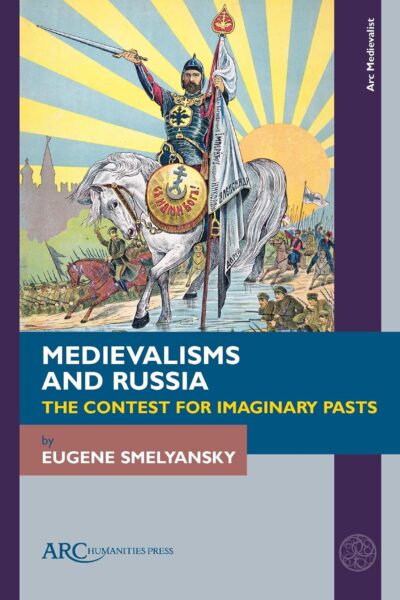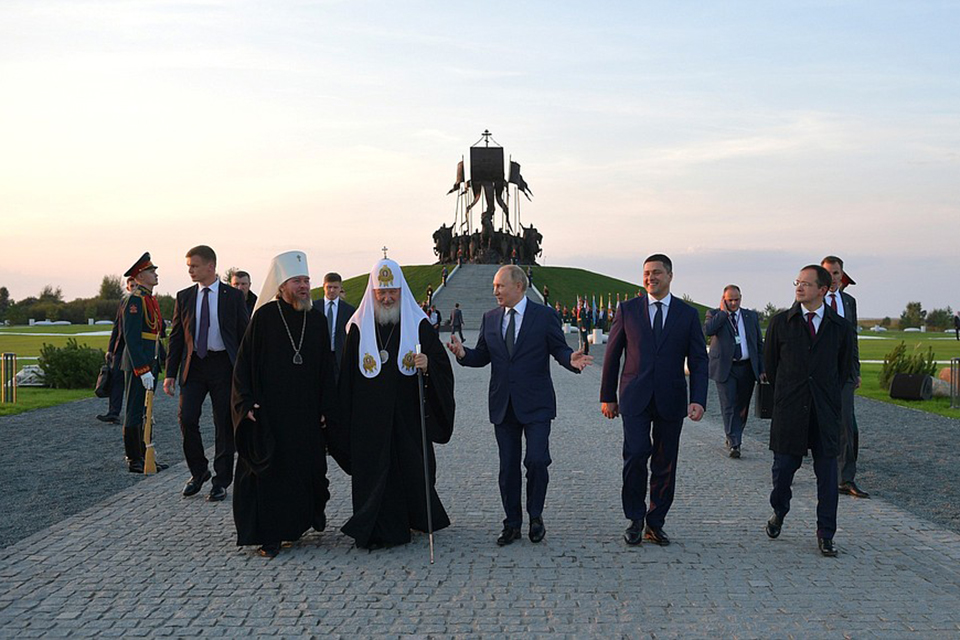How does Putin get his people to accept a megalomanic dream and a senseless war? By referring to a glorious medieval past, it appears
 In 2016, a statue of Vladimir the Great was raised just outside the walls of the Kremlin. Originally, the 24 metres high statue was expected to be raised at the Sparrow Hill, from where it would be visible in all of wider Moscow. This led to wide protests as well as a threat from UNESCO to move the Kremlin from its prestigious list of World Heritage.
In 2016, a statue of Vladimir the Great was raised just outside the walls of the Kremlin. Originally, the 24 metres high statue was expected to be raised at the Sparrow Hill, from where it would be visible in all of wider Moscow. This led to wide protests as well as a threat from UNESCO to move the Kremlin from its prestigious list of World Heritage.
One particular feature, however, was conveniently forgotten, namely that Vladimir was in fact not a Russian saint, but at best a Ukrainian saint, whose name should be spelt Volodymyr. Furthermore, he was not really of Ukrainian or Slavic descent, but the son of a Viking Rus’, Sveinald. His real name was Valdemar Sveinaldsson.
Nevertheless, the Russian authorities’ appropriated Valdemar aka Volodomir aka Vladimir as a Russian saint. This was no coincidence. Rather, we may be sure that the act was part of the aftermath of the invasion of Crimea and Ukraine in 2014, leading to the misjudged military conflict currently being waged in the region.
The question, though, is why Putin and his advisers would engage in such a costly propaganda stunt in which he referred to a 1000-year-old national saint? And this at a time when he was obviously planning his next strategic move: the all-out war against the West, of which we have only seen the first two instalments (the invasion in and the annexation of Crimea in 2014 and the war in 2022).
Why this medieval turn?

The answer, writes Eugene Smelyansky, in a new book, must be found in an older Russian tradition to refer to its medieval past, of which several prominent examples may be called upon to explain this enigma.
These famous examples are the classic film Alexandr Nevski from 1938, its 2008 sequel Alexander: the Battle of the Neva, and finally, The Fall of an Empire: the Lesson of Byzantium. In each of these propagandistic pieces of film history writing, Russia was portrayed as either under siege or attacked from without by enemies, which Mother Russia and her heroes were luckily able to vanquish. Of these, Alexander Nevsky (1221-1263) was even voted the “Greatest Russian” in 2008, even though Novgorod and its wider trading emporium reaching all the way beyond the Kara Sea was not part of Russia until 1478. In fact, Nevsky was a vassal of the Mongols and the Golden Horde. Nevertheless, it is true he successfully fought the Teutonic Knights in 1242 in the “Battle of the Ice”, offering him up as a useful paradigm for the future Russian soldier in the Great War which Russia was forced to take part in after 1942.

Then in 2008, a highly venerated sequel was filmed in which the young prince did not just fight the Germans, but also the Swedes. We may never know, but perhaps the film was part of the reason why Finland and Sweden recently joined NATO? In 2021, the Russians even planned to raise a statue of Nevsky in front of the KBG headquarters. In early August, 2023, the Russian occupiers of the port of Mariupol demolished a monument to the city’s Ukrainian defenders, announcing plans to replace it with a statue of Alexander Nevsky.
A third example explored by Smelyansky is the documentary from 2008, called “The Fall of an Empire: The Lesson of Byzantium”, which was the work of Tikhon Shevkunov, the Russian Orthodox priest serving as Putin’s confessor. In this documentary, Russia was shamelessly framed as the heir of the New Byzantium. The enemy, of course, were the crusaders sacking Constantinople leading to the final fall led by the Ottoman rulers in 1453. Out of these ashes, the medieval Russian myth goes grew a “New Rome”. Since 2015, a special TV channel (connected with Fox News) has spewed out endless medieval propaganda, much of it anti-semitic and homophobic. The name of the channel is Tsargrad TV.
The new book by Smelyansky explores in much more detail, how this invention of a glorified medieval past has been wielded to propagandic effect in Imperial, Soviet, and post-Soviet Russia. And not least, Putin trying to explain his military aggressions as defensive acts against the invading enemies of Russia.
From politicians’ speeches to popular culture, from Orthodox Christianity to neo-paganism, the medieval Russian past remains crucial in constructing national identity, mobilizing society during times of crisis, and providing alternative models of communal belonging.
Thus, the frequent appeals to Russia’s often romanticized and skewed medieval Slavic past, its heroes and myths, have provided and continue to provide – a particularly powerful tool for animating imperialist and populist sentiments. This study seeks to explain why a medieval past remains potent in Russian politics, society, and culture today.
Medievalisms and Russia: The Contest for Imaginary Pasts
by Eugene Smelyansky
Arc Humanities Press 2024
CONTENT:
Introduction
Chapter One: A Contested Inheritance: Medieval Rus and Russia’s Origin Myths
Chapter Two: Alexander Nevsky: The Once and Future Prince
Chapter Three: Byzantine Dreams: Russia as the “Third Rome”
Chapter Four: Medievalism as Allegory: The Middle Ages in Unofficial Culture
Conclusion
Select Bibliography
Index
ABOUT THE AUTHOR:
Eugene Smelyansky is a Teaching Assistant Professor of History at Washington State University and has written on Russian medievalisms for The Public Medievalist.
FEATURED PHOTO:
Unveiling of Memorial for Alexander Nevsky. With Metropolitan Tikhon (Shevkunov) of Pskov and Porkhov, Patriarch Kirill of Moscow and All Russia, Pskov Region Governor Mikhail Vedernikov and Presidential Aide Vladimir Medinsky (from left to right) after the ceremony unveiling the memorial complex Prince Alexander Nevsky and his Retinue.. Source: Russian Presidency CCBYSA.
READ ALSO:
Enemies at the Gate: Political Medievalism, Russian Style.
By Eugene Smelyansky
In: The Public Medievalist, 2021
Putin the Terrible
By Dina Khapaeva
Project Syndicate, 2 September 2022
Putin’s Dark Ages
Political Neomedievalism and Re-Stalinization in Russia
By Dina Khapaeva
Routledge2024
